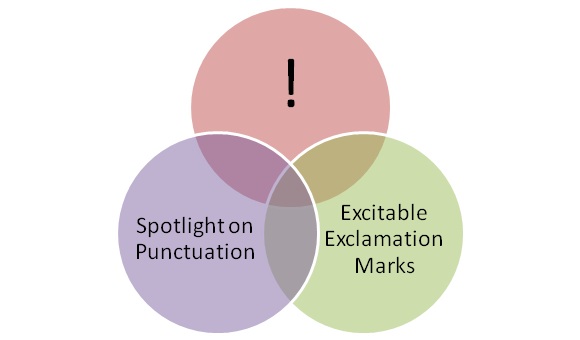Search
Latest tweets
Latest tweets
- No public Twitter messages.
Spotlight on Punctuation
Posted in: Blog, Punctuation, Spotlight on Punctuation by Sally Evans-Darby on 1 July 2012

Spotlight on Punctuation: Excitable Exclamation Marks
This week’s spotlight on punctuation takes a closer look at the exclamation mark (or point). It’s rather an exciting punctuation mark, as punctuation marks go. It immediately demands attention. It insists you sit up and take notice! (See what I did there?)
I think it’s safe to say that no-one really knows when or how the exclamation mark came into existence. There’s some rather spurious speculation that it was born from the Latin for ‘joy’ – ‘io’ – by writing the ‘I’ on top of the ‘o’. Possible, but unlikely. It comes with a wildly varied nomenclature; as well as being interchangeably a ‘mark’ or ‘point’, it’s also been known as a bang, a dembanger, a screamer, a gasper, a shriek and a startler. Not bad for what is essentially a vertical line with a dot beneath it.
The use of an exclamation mark can mean several things. It can indicate shouting in dialogue (‘It’s over here!’), an imperative (‘Fetch my coat!’), or, most usually, an expression loaded with emotion (an exclamation). This emotion might be excitement, anger, surprise, dismay. Consider the following examples and how in each instance the mark is used slightly differently:
Get away from me!
That was brilliant!
I can’t believe you said that!
Someone ate the last Rolo!
All these legitimately use the exclamation mark to convey the emotion of the sentence, and help to drive home to readers the significance of what is being said.
Interestingly, there is one more use of the exclamation point that has come into vogue the last decade or so, and that is using it as an indication of sarcasm. An exclamation mark in brackets at the end of a sentence denotes that whatever is being said is meant with a degree of irony, like a symbolised ‘…not!’, as in:
Gee, that’s a beautiful sweater you’re wearing (!)
This is used frequently in subtitles to help convey meaning, and, unsurprisingly, can most often be found in British English.
In Britain, there is even a place name whose spelling officially includes an exclamation point (Westward Ho!).
There is, however, one way to use an exclamation mark that will do nothing more than drive your readers up the wall. That, of course, is this!!!!!!!!!!!!!!!!!!!!!
That’s an extreme example, but in my opinion it is never acceptable or necessary to use more than two exclamation points together. Even two is pushing it, and should only ever be used in the very rare circumstances when one isn’t enough. That’s the crux when it comes to exclamation points: one is nearly always enough. One on its own can convey so much power that using more simply dilutes that power.
To go further, even using one exclamation point should be approached with caution. Always bear in mind who your potential reader is: is an exclamation mark really necessary or will a full-stop suffice? Consider the following sentence, expressed with and without an exclamation mark:
I can safely say, after much consideration, that today’s roast dinner was the best I have ever tasted.
I can safely say, after much consideration, that today’s roast dinner was the best I have ever tasted!
Which would you believe was less of a hyperbole, the first or second? I would argue that while the first rings with a grave and credible sobriety, the second loses its credibility by sounding exaggerated. And that is all down to that mischievous mark.
As F. Scott Fitzgerald put it: ‘An exclamation point is like laughing at your own jokes’. So, this week’s punctuation lesson: don’t let an exclamation mark make a fool out of you.
